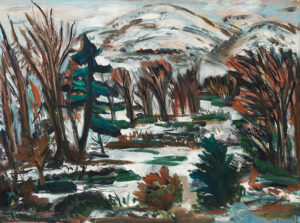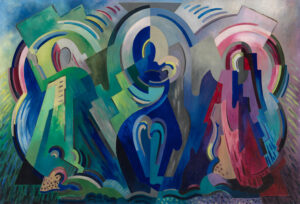Mainie Jellett and Evie Hone: The Art of Friendship,
by Niamh MacNally & Brendan Rooney, with texts by Sarah McAulife & Joseph McBrinn
(National Gallery, €45.00 / £39.00)
In 1924 the young Irish artists Evie Hone and her friend Mainie Jellett held their one and only joint exhibition in the gallery of the Society of Dublin Painters at 7 St Stephen’s Green.
Fresh from Paris where they both had made themselves students of Albert Gleizes, the artist and theorist of the latest art style, Cubism.
The Dublin show effectively brought this new wave of art into the new Irish state with a profound effect drawn out over the next thirty years or so.
Initially their reception by the art establishment in Dublin was a cool one, but decades later by the late 1940s they had created an appreciative international audience for their work. In a period which is now often derided as narrow and conventional their inventions reveal a creative arc of the first order, and suggests there was more to those years than is often accepted.
Inspiration
Mainie Jellett and Evie Hone both belonged to the settled middle class Protestant background by birth and education.
Both had a serious religious outlook; though it was Evie Hone who entered an Anglican convent in Cornwall in 1926, which she later left without taking her final vows. She was collected from the convent on leaving by her friend Mainie.
But her quest for faith continued, and brought her to convert to the Catholicism: she was received into the church by Rev. John Charles McQuaid (the future influential Archbishop of Dublin) at a private ceremony in Blackrock College in 1939.
Mainie Jellett died of cancer in 1944, visited on her last day by Evie Hone. Hone herself collapsed and died while on her way into mass in Rathfarnam in 1955.
Central to this present exhibition is a section devoted to “Divine Inspiration” where many aspects of their religious art are shown and explored. Their debt to earlier art is emphasised, especially in such pictures as Jellett’s Study after Fra Angelico (also known as Annunciation, from 1928), and Hone’s Composition (also from 1928).
Visitors will also wish to pause at Jellett’s I Have Trodden the Winepress Alone from 1943 – the reference to Isaiah, 63:3, a grimly disturbing allusion, which would have carried greater weight with Protestants than Catholics – Deposition (1939) and The Ninth Hour (1941), all quite the equal of Hone’s more renowned stained glass windows at Eton College and Clongowes Wood College, here in Ireland.
Some almost remind one of the Swiss watches in their intricacy, showing just how Parisian theories were recast as Irish art”
The book is made up of some eight essays by the authors, detailing step by step with the developing and changing stages of their careers: religion though important was not the only thing in their lives.
The catalogue annotates some 97 works of art. As well there are documentary images drawing on a range of archives public and private. Great care has been taken about the reproduction of these images, which provide a feast for the eye as well as food for the mind. Working plans and schemes from archives reveal the care and exactness that went into the planning and creation of the seeming slapdash “cubist” works. Some almost remind one of the Swiss watches in their intricacy, showing just how Parisian theories were recast as Irish art.
Also the sheer physical labour that had to go into the creation piece by piece of the large stained glass windows should not be overlooked; though Hone’s very lovely small work Avenue, St Catherine’s Leixlip is a delight.
Rarities
Curiously there is only one photograph, coarsely screened image in a clipping from the Dublin Evening Mail on November 21, 1930, showing them with a group of artists at an event, again in the St Stephen’s Green gallery. This fact emphasis just how private in a way they kept their lives, though their work enjoyed ever increasing exposure, especially the stained glass work created by Evie Hone.
It is a little surprising in this rarefied atmosphere to also encounter a poster by Mainie Jellett for Winsor & Newton Colours, and commissions from the Government of Ireland for A Map of Ireland from 1937 for the Irish Pavilion at the Glasgow Empire Exhibition (1938) and Hone’s My Four Green Fields, made for the New York World’s Fair in 1939 — now to be seen by visitors in Government Buildings at the head of the main staircase. These indicate a readiness to put their talents at the disposal of the government of the new Irish state.
The religious themes have a central place, which is strikingly different to what is now so often tacitly assumed in public matters of the arts today”
The late development of Hone as a landscape artist is also interesting, especially the sunny scenes in the sotuh of France. In a pen and ink with water colour composition (undated) there seems to be an echo of influence of the style of John Piper.
All in all this is an exhibition not to missed by anyone interested in any way in the development, not just of Irish art after 1924, but also in the development of Ireland itself over the years between the wars. The religious themes have a central place, which is strikingly different to what is now so often tacitly assumed in public matters of the arts today.
The images available for press use provide examples of the various styles of the artists; but these give only a very limited idea of the abundance of image making on show at the exhibition as a whole. The Cock and the Pot is a reference to the passages in the gospels recounting the betrayal of Jesus by St Peter as recalled in folklore.




 Peter Costello
Peter Costello 37.01 - Evie Hone, Stained glass: The Cock and Pot, commonly known as The Betrayal, c. 1947. Geraldine Hone, Kate Hone and the FNCI. Photo: National Gallery of Ireland
37.01 - Evie Hone, Stained glass: The Cock and Pot, commonly known as The Betrayal, c. 1947. Geraldine Hone, Kate Hone and the FNCI. Photo: National Gallery of Ireland 